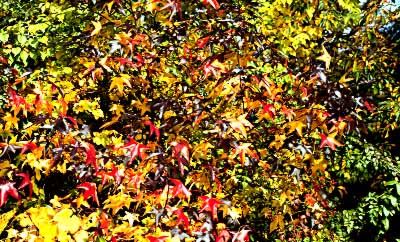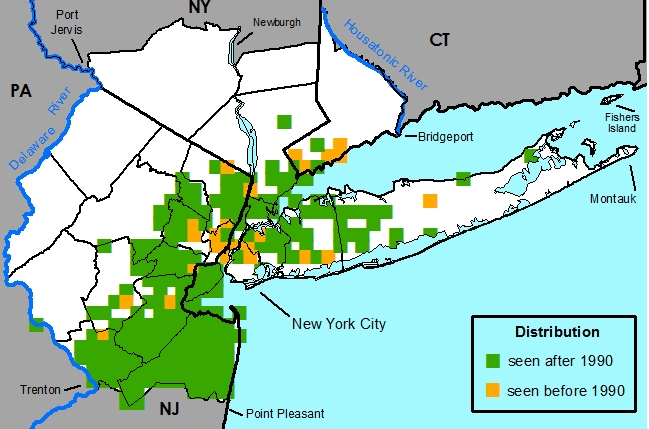Liquidambar styraciflua L. - Sweet Gum,Red Gum,Bilsted,White Gum,Storax-tree,Star-leaf Gum,Alligator-tree,Possum Tree,Copalm

Liquidambar styraciflua L.
Sweet-Gum
Native , Frequent
By Steven D. Glenn & Angela Steward
Not peer reviewed
Last Modified 02/15/2013

Common Names
Sweet Gum,Red Gum,Bilsted,White Gum,Storax-tree,Star-leaf Gum,Alligator-tree,Possum Tree,CopalmField Identification
Large tree up to 100 feet tall, star-shaped leaves with five pointed lobes, branches with corky wings and ridges, brown-black bark deeply furrowed, ball-shaped spiny fruits hanging at the end of long stalks.Food uses
Disclaimer: The information provided here is for reference and historical use. We do not recommend nor do we condone the use of this species for food purposes without first consulting a physician.(Felter, 1922) (Moerman, 1998)
Native Americans chewed the sap for its sweet taste and mixed the bark with other ingrediants to make a tea.
Medicinal uses
Disclaimer: The information provided here is for reference and historical use. We do not recommend nor do we condone the use of this species for medicinal purposes without first consulting a physician.(Felter, 1922) (Moerman, 1998)
Native Americans used the sap to treat a variety of disorders. Combined with lard or tallow, the sap makes an antiseptic ointment useful in treating cuts and bruises, skin disorders, ringworm, and hemorrhoids. The roots of the plant can be used to alleviate skin disorders, diarrhea, dysentery and high fevers.
Other uses
Sweet sap used in soaps, cosmetics, perfumes, adhesives, lacquers, incense, and as a flavoring in tobacco. The durable fine-grained wood is used for making furniture and other items such as barrels, wooden bowls, cabinets, and interior finishing. Meyer (p. 367), 1997
Used as an ornamental in landscaping situations with a number of cultivars selected, hardy to USDA zone 5b. (Rehder, 1940) (Flint, 1983) (Santamour & McArdle, 1984)
Stories
The name comes from Latin, liquidus, fluid, and Arabic, ambar, resin. (Ernst, 1963)
Nomenclature
*Liquidambar styraciflua L., Sp. Pl. 2: 999. 1753.Liquidamabr gummifera Salisb., Prodr. Stirp. Chap. Allert. 393. 1796.
Liquidambar barbata Stokes, Bot. Mat. Med. 4: 332. 1812.
Liquidambar macrophylla Oersted, Am. Centr. 16, t. 10. 1863.
Liquidambar styraciflua var. mexicana (L.) Oersted, Am. Centr. 16, t. 11. 1863.
Liquidambar styraciflua suberosa Schwerin, Mitt. Deutsch. Dendr. Ges. 1933(45): 390, t. 52. 1933.
TYPE: unknown
*Liquidambar styraciflua f. rotundiloba Rehd., J. Arnold Arb. 12: 70, fig. 1931.
TYPE: USA, North Carolina, near Pinehurst, R. E. Wicker, s.n. Sept. 15, 1930.
Description
HABIT Perennial, deciduous, phanerophytic, tree, diclinous and monoecious, to 18-35 (40) m.STEMS Main stems erect, round. Bark gray to almost black, furrowed, not exfoliating. Branches erect to ascending to horizontal, with pronounced corky wings and ridges. Twigs red-brown on 1st year, brown to gray on older twigs, terete, 2.5-5 mm in diameter, smooth, glabrous and lenticulate, older twigs developing corky wings and ridges. For a study of the corky wings see Gregory, 1888. Pith brown, star-shaped to terete. Resin clear brownish-yellow, thick, with aromatic odor. For an anatomical study of the mycorrhizal-root interface see Vozzo & Hacskaylo, 1964.
BUDS Terminal and axillary present, scattered along stem; ovoid, 4-10 mm long, blunt or pointed. Bud scales about 6, brown to orange-brown, imbricate, triangular-deltoid, glabrous except for ciliate margins, glossy. Bud scale scars encircling the twig. Leaf scars crescent-shaped. Vascular bundle scars 3, crescent-shaped.
LEAVES Alternate, simple, spaced somewhat evenly along and divergent from stem. Stipules lateral, linear-lanceolate, 3-4 mm, deciduous. Leaves with terete petiole, 2-10 cm long, glabrous. Leaf blades: 5-20(25) cm long, 4-18 cm wide, bilaterally symmetric, base cordate or truncate; margins serrate; palmately 5(7)-lobed, lobes 1/4-1/2 the distance to the midvein, with acute apices (f. rotundiloba has obtuse apices). Considerable variation can exist in lobing, see Holm, 1930 Duncan, 1959. Abaxial surface light green to light yellowish green, glabrous except for tufts of simple brown hairs in vein axils at base. Adaxial surface green to dark green, glabrous. Actinodromous (palmately veined).
INFLORESCENCES Coetaneous-serotinous, formed on last season's growth, complex, bisexual (or occasionally unisexual), terminal, racemose. Proximally with one to three long-pedunculate and pendant pistillate spherical heads comprised of many flowers, subtended by 1 or more minute deciduous bracts; followed distally by 15-20 short-pedunculate to sessile staminate heads comprised of globular masses of stamens, subtended by 1 minute deciduous bract. Occasionally the lower staminate heads contain partially developed but sterile gynoecium. Also occasionally all heads are pistallate. Peduncles and rachis sparsely to moderately covered with simple long brown hairs. (Bogle, 1986) (Schmitt, 1966)
FEMALE FLOWERS Usually functionally unisexual, lacking perianth. Gynoecium: ovary syncarpous, with 2(1-6) carpels, semi-inferior, locules 1-2, placentation parietal-axile. For a study of megasporogenesis see Flint, 1959. Styles 2, persistent and indurate in fruit. Stigmas 1 mm long, recurved. At the base of the carpels is a cycle of minute "bracteoles" ("phyllomes" "papillae"), for interprative discussion see Bogle, 1986. Androecium: consists of a cycle of 5-8 (4-10?) staminodes subtending the "bracteoles", varing from strongly reduced and sterile to fully developed anthers containing sterile or even fertile pollen. Anthers may be sessile or on short filaments.
MALE FLOWERS Usually functionally unisexual, lacking perianth. Gynoecium: absent or with rudimentary carpels. Androecium: 4-8(10) stamens in one cycle, 2-3 mm long, glabrous. Anthers dehiscing along two longitudinal slits.
FRUITS Dark brown indurate, glossy, glabrous 2-beaked septicidal capsules, each capsule containing 1-2 seeds; capsules concrescent below, forming a globose head, 2.5-3.5 cm in diameter.
SEEDS Shiny dark brown to gray, oblong-flattened, 7-10 mm long; including an apical wing usually lighter in color. Aborted seeds 1-2 mm, unwinged, irregular, "resembling sawdust". For a brief anatomical survey see Young & Young, 1992.
Habitat
Moist to mesic fields, woodlands, flood plains, swamps, riverbanks, and alluvial woods. In one study about 95% of sweetgum seedlings survived continuous root flooding for more than two years (Angelov, et al., 1996).Distribution
United States – AL, AR, CT, DC, DE, FL, GA, IL, IN, KY, LA, MA, MD, MO, MS, NC, NJ, NY, OH, OK, PA, RI, SC, TN, TX, VA, WV.
New York Metropolitan Region – Restricted to coastal counties in CT, NJ and NY
Rarity Status
Heritage global rank -- G5Connecticut -- Special Concern
New Jersey -- Not listed
New York -- Not listed
Species Biology
August [week 4] - November [week 4]. Empty fruiting heads remain on tree overwinter. Mast crops about every 3 years.
In nature, moist soil with good light is optimal, germination is epigeous. Seed exhibit shallow dormancy, germination enhanced by moist stratification at 2-5d C for 15-90 days. Seed can be kept in dry storage at low temperature for at least 1 year.